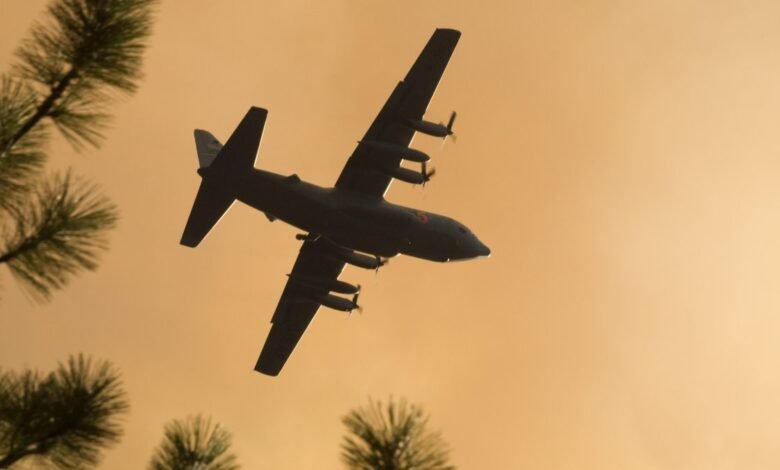

Enormous C-130 military planes will soar over Angeles National Forest this week in a training exercise for military pilots learning to fly the modified aircraft in steep terrain to fight wildfires.
The behemoth four-engine turboprop military transport planes equipped to fight fires are part of a training class for personnel at Channel Islands Air National Guard (ANG) Station in Port Hueneme. The training started Wednesday and will continue into Saturday.
The C-130s, also known as the Hercules, are outfitted with Modular Airborne Firefighting Systems (MAFFS), which turn the planes into temporary airtankers when the Air National Guard is called out help fight wildfires.
The planes will make drops in designated zones in the northwest part of Angeles National Forest in LA County. All drop zones are in remote areas. Nearby residents and forest visitors will likely see the aircraft flying low and smaller lead planes during the exercises.
The planes will drop water — not the red fire retardant familiar to Southern Californians — during the training.
MAFFS-equipped aircraft were part of the response to the Palisades and Eaton fires in January. The eight C-130 Hercules aircraft in the MAFFS program can drop up to 3,000 gallons of fire retardant in less than 10 seconds across a quarter-mile line, helping to slow and stop a fire’s spread.
MAFFS equipment slides into the back of the C-130 military aircraft and retardant or water is released through a nozzle on the rear left side of the plane.
The MAFFS planes, part of a decades-old program, are activated when all commercial airtankers that are part of the national airtanker fleet are already assigned to a fire or not readily available. Congress established the MAFFS system in the 1970s after a major fire in the Long Beach area that destroyed hundreds of homes and stretched the civilian tanker fleet.
“The MAFFS program is an important supplement to our national airtanker capacity,” said Sarah Fisher, director of Fire and Aviation Management for the USDA Forest Service. “The program is a tremendous example of how the federal and state wildland fire agencies work cooperatively with the military.”
Also Wednesday, anyone in the forest near the communities of La Canada-Flintridge and the lower Big Tujunga area, and the Littlerock, Juniper Hills, Pearblossom, Devil’s Punchbowl, and Crystal Airport might see and smell smoke from a prescribed burn.
[publish_date








